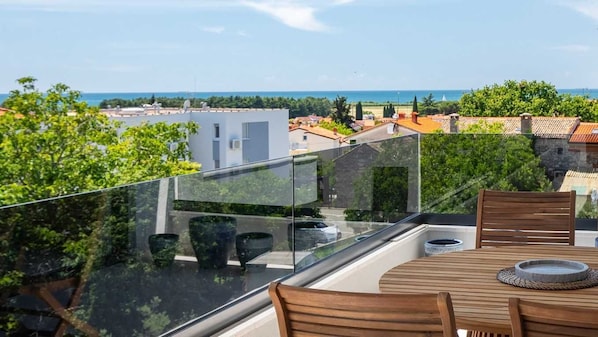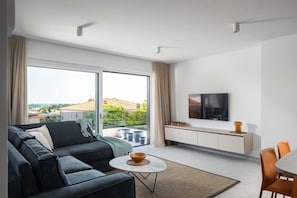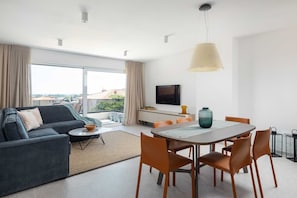Apartment
B&M apartments Novigrad
Photo gallery for B&M apartments Novigrad





2 bedrooms2 bathroomsSleeps 6100 sq m
Popular amenities
Explore the area

Novigrad
- Karpinjan Beach13 min walk
- Novigrad Harbour18 min walk
- Lanterna Beach21 min drive
- Portoroz (POW)23 min drive
Rooms & beds
2 bedrooms (sleeps 6)
2 bathrooms
Bathroom: 1
Bathroom: 2
Spaces
Kitchen
Balcony
Separate dining area
About this property
B&M apartments Novigrad
The facility is located on the first floor of a newly built building. It consists of a living room, 2 bedrooms, kitchen, dining room, two bathrooms and a terrace. A parking space is available. The city center is only an 8-minute walk away. There is a 5 km recreational hiking trail through the forest nearby. Those staying on the terrace can enjoy a wonderful view of the city of Novigrad and the beautiful Adriatic Sea.
Novigrad (Italian: Cittanova; Venetian: Sitanova) is a town in Istria County in western Croatia. It is also sometimes referred to as Novigrad Istarski (Cittanova d'Istria; Sitanova d'Ìstria) to distinguish it from three other Croatian towns of the same name.
Novigrad is set on a small peninsula on the western coast of Istria, two kilometres (1.2mi) north of the mouth of the river Mirna and some 25km (16mi) south of the border with Slovenia.
There was an ancient city in the broad area of what is now Novigrad, which was called Aemona. In the 5th and 6th centuries, Novigrad was called Neapolis (Greek Νεάπολις). From the early Middle Ages and right up until 1828 it was the seat of the Diocese of Novigrad, which has been identified with the Ancient see of Aemona and nominally restored as Latin Catholic titular see under both names. From 1270 it was under the rule of the Venetian Republic, which gave it the Italian name of Cittanova, until Venice fell in the late 18th century. According to the 1921 census, there were no Croats in Novigrad.
Situated on a peninsula, Novigrad has retained its medieval structure and layout, with narrow, winding streets and small shops. The fortifications belong to the medieval era: the town wall still stands with its battlements and two round towers. There are examples of secular architecture from the time of the Venetian empire, such as the town loggia and several houses built in Venetian Gothic style.
The present church was built in the 15th and 16th centuries on the foundations of the 8th-century basilica of Saint Pelagius that had a nave and two aisles. Under the present presbytery is a late Romanesque crypt. In the sacristy are 15th-century antiphonaries with beautiful simple initials.
Novigrad was the host of the 2016 nine-pin bowling Single's World Championships.
Porečis a town located in the heart of the western coast of theIstrian peninsula, in Istria County. The city is almost 2,000 years old; the remains of ancient temples and forums are spread throughout the old city centre. The most valuable and recognizable cultural and historical monument is theEuphrasian Basilica, present on UNESCO World Heritage List, dating back to the 6th century.
Today the city is a vibrant and modern place balancing perfectly between history and present. The language spoken in Poreč is Croatian, but due to its history, it is not unusual to hear Italian language on the streets. Last recorded number of Poreč population has shown that there are around 16,700 inhabitants; their main occupation includes olive and fruit growing, fishing and tourism.
Poreč is apopular tourist destinationfamous for its beautiful natural landscape, a long tradition in tourism and several well-equipped tourist resorts. TheMediterranean climatewith mild winters and warm summers makes the city enjoyable to visitors all year round. Summer season is perfect for beach fun, swimming and sunbathing, while in the off-season you can avoid the crowds and enjoy the town peacefully .
A few kilometres outside Novigrad, Istralandia is a large aquapark complex with six pools, including a children’s spray arena, and 15 kinds of slides. Kids can try the Black Kamikaze, Family Rafting and, for toddlers, Crazy Hills. As of 2019, there will be a new feature, Space Combo, offering nearly 200 metres of space adventure in a rubberised vehicle with full visual effects. Other attractions include beach football, beach volleyball, concerts and all kinds of courses and workshops.
Situated on thewest coast of Istria, Rovinj is one of the most popular and most developed tourist resorts inCroatia. The old town is built on the island, which was only connected with the mainland in the 18thcentury. Known as one of the most picturesque and romantic towns on Mediterranean, over the last few decades Rovinj attracts a large number of tourists, most of them faithfully returning year after year. Why do they come back? Maybe it is the breath of past times felt as you walk around old town's cobbled narrow streets. Or is it maybe its 22 islands and islets,the mild Mediterranean climate, carefully designed parks, the tidiness of its streets, the friendliness of the local population or numerous and varied town events. Or all of it!
Rovinj manages to combine, in a very interesting way, its rich tradition with the modern times. As it is also an active fishing port, you can experience the atmosphere of a small fishing village, especially during the popular fishermen’s festivities or at one of the traditional taverns called Spacio (in the past, very popular among fishermen). On the other hand, the town has been developing an exquisite gastronomy and offers a high standard of tourist services in general.
The city at the foot of the Church of St. Euphemia is the favorite gathering place of artists from around the world. Walking down its streets, you'll bump into many art galleries and studios, whilst once a year, in August, you have the possibility to attend the largest open-air exhibition of the Adriatic coast, which takes place in one of the main old-town streets - Grisia.
It is almost impossible to list all Rovinj's attractions, so we suggest visiting it and surrendering to its beauty… We are sure that it will win you over and that sooner or later, you’ll come to visit Rovinj again.
What to see and do in Umag
Although it dates back to the ancient times,Umag has preserved only the Medieval architecture. The remnants of this are seen in the city walls, Venetian villas, picturesque streets… As already mentioned,the Old Town is now on a peninsulawhich was once an island. In the 10thcentury the city walls were built around the settlement and which was connected to the mainland by a drawbridge.
The best preserved buildingis also the oldest one – the west tower which houses the Museum of the City.
In the centre there is a square withthe church of the Assumption of Mary.
A little bit outside Umag, in Savudrija,you can visit the oldest lighthouse in Croatia. It was built in 1818 and there is a legend about its construction. Metternich,an Austrian count, fell in love with a Croatian lady at a Viennese ball so he had this lighthouse built only for her. However, she got ill and never got to see it, so the count decided to never again visit the lighthouse.
In Umag, and some other Istrian cities as well,Sole Fish Days are held every year. This manifestation lasts for a month and is held in restaurants which offer 4 course menus based on common sole, accompanied by excellent Istrian wines and olive oil.
In order to prolong the wellness season,Umag offers the days of wellness, Welldays, which take place during October. Three hotel wellness centres offer special packages which include staying in a comfortable hotel, half-board service and daily entrance to the wellness center.
Music loverscan enjoy the UmagoBlues music festivaland taste some of the local specialties.
Another festival isUmagination which is a festival of electronic musictaking place in Umag for four years.
What Umag is most famous for is theATPCroatian Open Umag tennis tournamentwhich takes place every year in July.
Generally speaking, in terms of sport, there is always something going on in Umag whether it is about tennis, football, golf…
Novigrad (Italian: Cittanova; Venetian: Sitanova) is a town in Istria County in western Croatia. It is also sometimes referred to as Novigrad Istarski (Cittanova d'Istria; Sitanova d'Ìstria) to distinguish it from three other Croatian towns of the same name.
Novigrad is set on a small peninsula on the western coast of Istria, two kilometres (1.2mi) north of the mouth of the river Mirna and some 25km (16mi) south of the border with Slovenia.
There was an ancient city in the broad area of what is now Novigrad, which was called Aemona. In the 5th and 6th centuries, Novigrad was called Neapolis (Greek Νεάπολις). From the early Middle Ages and right up until 1828 it was the seat of the Diocese of Novigrad, which has been identified with the Ancient see of Aemona and nominally restored as Latin Catholic titular see under both names. From 1270 it was under the rule of the Venetian Republic, which gave it the Italian name of Cittanova, until Venice fell in the late 18th century. According to the 1921 census, there were no Croats in Novigrad.
Situated on a peninsula, Novigrad has retained its medieval structure and layout, with narrow, winding streets and small shops. The fortifications belong to the medieval era: the town wall still stands with its battlements and two round towers. There are examples of secular architecture from the time of the Venetian empire, such as the town loggia and several houses built in Venetian Gothic style.
The present church was built in the 15th and 16th centuries on the foundations of the 8th-century basilica of Saint Pelagius that had a nave and two aisles. Under the present presbytery is a late Romanesque crypt. In the sacristy are 15th-century antiphonaries with beautiful simple initials.
Novigrad was the host of the 2016 nine-pin bowling Single's World Championships.
Porečis a town located in the heart of the western coast of theIstrian peninsula, in Istria County. The city is almost 2,000 years old; the remains of ancient temples and forums are spread throughout the old city centre. The most valuable and recognizable cultural and historical monument is theEuphrasian Basilica, present on UNESCO World Heritage List, dating back to the 6th century.
Today the city is a vibrant and modern place balancing perfectly between history and present. The language spoken in Poreč is Croatian, but due to its history, it is not unusual to hear Italian language on the streets. Last recorded number of Poreč population has shown that there are around 16,700 inhabitants; their main occupation includes olive and fruit growing, fishing and tourism.
Poreč is apopular tourist destinationfamous for its beautiful natural landscape, a long tradition in tourism and several well-equipped tourist resorts. TheMediterranean climatewith mild winters and warm summers makes the city enjoyable to visitors all year round. Summer season is perfect for beach fun, swimming and sunbathing, while in the off-season you can avoid the crowds and enjoy the town peacefully .
A few kilometres outside Novigrad, Istralandia is a large aquapark complex with six pools, including a children’s spray arena, and 15 kinds of slides. Kids can try the Black Kamikaze, Family Rafting and, for toddlers, Crazy Hills. As of 2019, there will be a new feature, Space Combo, offering nearly 200 metres of space adventure in a rubberised vehicle with full visual effects. Other attractions include beach football, beach volleyball, concerts and all kinds of courses and workshops.
Situated on thewest coast of Istria, Rovinj is one of the most popular and most developed tourist resorts inCroatia. The old town is built on the island, which was only connected with the mainland in the 18thcentury. Known as one of the most picturesque and romantic towns on Mediterranean, over the last few decades Rovinj attracts a large number of tourists, most of them faithfully returning year after year. Why do they come back? Maybe it is the breath of past times felt as you walk around old town's cobbled narrow streets. Or is it maybe its 22 islands and islets,the mild Mediterranean climate, carefully designed parks, the tidiness of its streets, the friendliness of the local population or numerous and varied town events. Or all of it!
Rovinj manages to combine, in a very interesting way, its rich tradition with the modern times. As it is also an active fishing port, you can experience the atmosphere of a small fishing village, especially during the popular fishermen’s festivities or at one of the traditional taverns called Spacio (in the past, very popular among fishermen). On the other hand, the town has been developing an exquisite gastronomy and offers a high standard of tourist services in general.
The city at the foot of the Church of St. Euphemia is the favorite gathering place of artists from around the world. Walking down its streets, you'll bump into many art galleries and studios, whilst once a year, in August, you have the possibility to attend the largest open-air exhibition of the Adriatic coast, which takes place in one of the main old-town streets - Grisia.
It is almost impossible to list all Rovinj's attractions, so we suggest visiting it and surrendering to its beauty… We are sure that it will win you over and that sooner or later, you’ll come to visit Rovinj again.
What to see and do in Umag
Although it dates back to the ancient times,Umag has preserved only the Medieval architecture. The remnants of this are seen in the city walls, Venetian villas, picturesque streets… As already mentioned,the Old Town is now on a peninsulawhich was once an island. In the 10thcentury the city walls were built around the settlement and which was connected to the mainland by a drawbridge.
The best preserved buildingis also the oldest one – the west tower which houses the Museum of the City.
In the centre there is a square withthe church of the Assumption of Mary.
A little bit outside Umag, in Savudrija,you can visit the oldest lighthouse in Croatia. It was built in 1818 and there is a legend about its construction. Metternich,an Austrian count, fell in love with a Croatian lady at a Viennese ball so he had this lighthouse built only for her. However, she got ill and never got to see it, so the count decided to never again visit the lighthouse.
In Umag, and some other Istrian cities as well,Sole Fish Days are held every year. This manifestation lasts for a month and is held in restaurants which offer 4 course menus based on common sole, accompanied by excellent Istrian wines and olive oil.
In order to prolong the wellness season,Umag offers the days of wellness, Welldays, which take place during October. Three hotel wellness centres offer special packages which include staying in a comfortable hotel, half-board service and daily entrance to the wellness center.
Music loverscan enjoy the UmagoBlues music festivaland taste some of the local specialties.
Another festival isUmagination which is a festival of electronic musictaking place in Umag for four years.
What Umag is most famous for is theATPCroatian Open Umag tennis tournamentwhich takes place every year in July.
Generally speaking, in terms of sport, there is always something going on in Umag whether it is about tennis, football, golf…
Property manager
Branislav
Languages
English, German
Add dates for prices
Amenities
Kitchen
Washer
Dryer
Free WiFi
Air conditioning
Beach view
Have a question?
BetaGet instant answers with AI powered search of property information and reviews.
House Rules
Children
Children allowed: ages 0–17
Events
No events allowed
Pets
No pets allowed
Smoking
Smoking is not permitted
Important information
You need to know
Extra-person charges may apply and vary depending on property policy
Government-issued photo identification and a credit card, debit card or cash deposit may be required at check-in for incidental charges
Special requests are subject to availability upon check-in and may incur additional charges; special requests cannot be guaranteed
On-site parties or group events are strictly prohibited
Host has not indicated whether there is a carbon monoxide detector on the property; consider bringing a portable detector with you on the trip
Host has not indicated whether there is a smoke detector on the property
Property Registration Number HR01813300089
About the area
Novigrad
Novigrad is home to this apartment. Rigo Patrician Palace and Decumanus Street are local landmarks, and some of the area's activities can be experienced at Stancija Fava Winery and Karpinjan Beach. Aquapark Istralandia and Aqua Golf Porec are also worth visiting.

Novigrad
What's nearby
- Novigrad Marina - 12 min walk - 1.1 km
- Karpinjan Beach - 13 min walk - 1.1 km
- Novigrad Harbour - 18 min walk - 1.5 km
- Aquapark Istralandia - 8 min drive - 6.0 km
- Lanterna Beach - 21 min drive - 13.1 km
Getting around
Restaurants
- Hoshi Restaurant - 18 min walk
- Adria Grill - 17 min walk
- Piazza Grande - 4 min drive
- Tri Palme - 17 min walk
- Lungomare - 10 min walk
Frequently asked questions
Reviews
Reviews
No reviews yet
Be the first to leave a review for this property after your stay.
About the host
Hosted by Branislav
Explore Novigrad
Welcome to Novigrad-Cittanova, tourist resort on the west coast of Istria, the town proud of its peacefulness, cordiality and beauty as well as of its rich historical and cultural heritage. Novigrad-Cittanova opens gladly its doors to everyone, its citizens will welcome and host every visitor trying to make the time she/he spends in our town as pleasant and memorable as possible.
Welcome to Novigrad-Cittanova, tourist resort on the west coast of Istria, the town proud of its peacefulness, cordiality and beauty as well as of its rich historical and cultural heritage. Novigrad-Cittanova opens gladly its doors to everyone, its citizens will welcome and host every visitor trying to make the time she/he spends in our town as pleasant and memorable as possible.
What makes this property unique
ISTRALANDIA AQUAPARK
A few kilometres outside Novigrad, Istralandia is a large aquapark complex with six pools, including a children’s spray arena, and 15 kinds of slides. Kids can try the Black Kamikaze, Family Rafting and, for toddlers, Crazy Hills. As of 2019, there will be a new feature, Space Combo, offering nearly 200 metres of space adventure in a rubberised vehicle with full visual effects. Other attractions include beach football, beach volleyball, concerts and all kinds of courses and workshops.
RESTAURANTS
Overlooking the marina that this luxury hotel serves, the Restaurant Navigare offers top notch Istrian cuisine, prepared in an open kitchen, to guests and non-guests alike. Executive chef Nenad Lukač is on a mission to prove that the gastronomy of this region can challenge that of France or Italy, and your experience here is a memorable part of that process. The à la carte menu changes with the seasons, with local hams, asparagus and truffles a key feature according to availability. Ingredients are locally sourced whenever possible. The house sea plate to start would be a wise choice, the sea bass carpaccio if you’re saving yourself for a satisfying main, buzara Nautica, say, with scampi and mussels, or the hefty veal ispod peke. Nautica chocolate fantasy rounds things off nicely for dessert.
WINERY
Just past the bus station on the outskirts of town, Moreno Ivančić is a small, family-run winery where visitors may drop in to sample the goods any day of the week. No reservation is required. The small-batch reds and whites here have a slight mineral quality and may be accompanied by fine Istrian prosciutto. Also available is rakija, as the firm has also started producing its own strong, clear spirits. Everything takes place in convivial sit-down surroundings, with more structured visits, including tours of the cellar, on offer for groups of six or more.
OBSERVATORY
A short drive from Novigrad, the modest village of Višnjan is a popular destination thanks to its world-famous observatory. Thanks to the lack of light pollution in this part of inland Istria, some 100 minor planets, two comets and more than 1,000 asteroids have been discovered here. The observatory also lays on tours, workshops and viewing sessions on certain nights of the year, with English-language explanations provided.
LAPIDARIUM
The Lapidarium in the heart of Novigrad is both a fascinating collection of local architecturalremains, and a prime exactly of how to design a contemporary, site-specific museum in a town’s historic centre. Designed by the award-winning Rendić and Turato, the Lapidarium contains pieces from pre-Roman times discovered around the former cathedral, today’s Church of St Pelagius. Early Christian symbols can also be discerned, delicately carved intertwining patterns and an array of animals and mythical beasts.
A few kilometres outside Novigrad, Istralandia is a large aquapark complex with six pools, including a children’s spray arena, and 15 kinds of slides. Kids can try the Black Kamikaze, Family Rafting and, for toddlers, Crazy Hills. As of 2019, there will be a new feature, Space Combo, offering nearly 200 metres of space adventure in a rubberised vehicle with full visual effects. Other attractions include beach football, beach volleyball, concerts and all kinds of courses and workshops.
RESTAURANTS
Overlooking the marina that this luxury hotel serves, the Restaurant Navigare offers top notch Istrian cuisine, prepared in an open kitchen, to guests and non-guests alike. Executive chef Nenad Lukač is on a mission to prove that the gastronomy of this region can challenge that of France or Italy, and your experience here is a memorable part of that process. The à la carte menu changes with the seasons, with local hams, asparagus and truffles a key feature according to availability. Ingredients are locally sourced whenever possible. The house sea plate to start would be a wise choice, the sea bass carpaccio if you’re saving yourself for a satisfying main, buzara Nautica, say, with scampi and mussels, or the hefty veal ispod peke. Nautica chocolate fantasy rounds things off nicely for dessert.
WINERY
Just past the bus station on the outskirts of town, Moreno Ivančić is a small, family-run winery where visitors may drop in to sample the goods any day of the week. No reservation is required. The small-batch reds and whites here have a slight mineral quality and may be accompanied by fine Istrian prosciutto. Also available is rakija, as the firm has also started producing its own strong, clear spirits. Everything takes place in convivial sit-down surroundings, with more structured visits, including tours of the cellar, on offer for groups of six or more.
OBSERVATORY
A short drive from Novigrad, the modest village of Višnjan is a popular destination thanks to its world-famous observatory. Thanks to the lack of light pollution in this part of inland Istria, some 100 minor planets, two comets and more than 1,000 asteroids have been discovered here. The observatory also lays on tours, workshops and viewing sessions on certain nights of the year, with English-language explanations provided.
LAPIDARIUM
The Lapidarium in the heart of Novigrad is both a fascinating collection of local architecturalremains, and a prime exactly of how to design a contemporary, site-specific museum in a town’s historic centre. Designed by the award-winning Rendić and Turato, the Lapidarium contains pieces from pre-Roman times discovered around the former cathedral, today’s Church of St Pelagius. Early Christian symbols can also be discerned, delicately carved intertwining patterns and an array of animals and mythical beasts.
Languages:
English, German
Tell us how we can improve our siteShare feedback